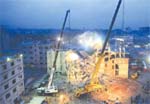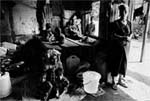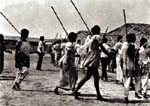The post Savar horror documented in photographs appeared first on Dhaka Mirror.
]]> The heart-wrenching sufferings of the victims of the recent building collapse in Savar have been captured by 17 photographers whose works have been exhibited at Drik Gallery in Dhanmondi.
The heart-wrenching sufferings of the victims of the recent building collapse in Savar have been captured by 17 photographers whose works have been exhibited at Drik Gallery in Dhanmondi.The six-day exhibition titled Tragedy Noy Hottakando displays 47 untitled images of wounded garments workers, deformed dead bodies, lamentation of the poor and helpless people over the loss of their loved ones making the viewers melancholic at recalling the impact of the building collapse on April 24, 2013 in Savar.
The images graphically portraying the tragedy not only deeply sadden the viewers but also infuriate them as they realise that this devastating horror, which is nothing short of a mass murder could have been avoided if the building and garment owners were not so negligent and greedy.
A bird view of the collapsed building has been arrested by Sazid Hossain in one of his snaps. The pile of debris in the image gives the spectators an idea of the ruin that claimed 1127 lives and injured another 2438 people.
One of the photographs by Ismail Ferdous shows a woman holding a photograph of a missing person during the incident. The grief and anxiousness on the face of the woman for her close one highlights the helplessness of family members of victims of the tragedy.
Tushikur Rahman’s image has captured a wounded young girl, most likely a garments worker on a hospital bed. The expression of the girl clearly reveals her vulnerability in the post trauma.
Inaugurated on May 31, the exhibition will remain open for everyone from 3:00 to 8:00pm till today.
-With New Age input
The post Savar horror documented in photographs appeared first on Dhaka Mirror.
]]>The post No Place To Call Home for Rohingyas appeared first on Dhaka Mirror.
]]> The untold miseries of the Rohingya people, a minority ethnic group of refugees in Myanmar have been captured
The untold miseries of the Rohingya people, a minority ethnic group of refugees in Myanmar have been capturedthrough lenses of two photographers.
40 such photographs have been displayed at a month-long duet exhibition titled No Place To Call Home at the Athena Gallery
at Badda in the capital.Greg Constantine and Saiful Shafiq Huq Omi have displayed an equal number of images each at the exhibition sponsored by European Union and UNHCR – The UN Refugee Agency.
The origin of the Rohingya people is disputed with some saying they are indigenous to the state of Rakhine (also known as Arakan, or Rohang in the Rohingya language) in Burma and others contending that they are Muslim migrants who originated from East Bengal, later Bangladesh, and migrated to Burma sometime during the British rule ea. Condemning them as intruders, the local Burmese people deny their right to stay in Myanmar, often kill them in riots and drive them out of the country.
Omi has photographed the Rohingya refugees in Bangladesh, Malaysia and the United Kingdom while Constantine has documented their condition in Myanmar during his travels to the Rakhine State in 2012 and 2013. All the images are untitled and in black and white.
Women and children living in shabby huts have been captured in one of the images by Constantine. The image depicts women with small children on their laps, huddled together in a tiny room crowded with household utensils including pottery, jars, bowls, plastic buckets among others. Clothes for drying can also be seen hanging in the room. The innocence as well as fear in the eyes of the children touches the hearts of the spectators. A teenage girl and an elderly man sitting helplessly inside a refugee camp have also been brilliantly arrested by Constantine in another snap.
Omi, through his lens, has secured a Rohingya man in action-arduously digging a well revealing the continuous hardship of an average refugee to satisfy fundamental needs. Another photograph by Omi portrays an old Muslim man doing adulation in an open air washroom before saying his prayers while a small child right beside the man, is showering using a small pitcher. Despite all the struggles and hardships those unfortunate people have to endure, the smiling face of the child reveals Rohingya people’s continuing hope for a better, respectable life.
Inaugurated on May 11, the exhibition will remain open for everybody from 12:00 to 8:00pm till June 11.
-With New Age input
The post No Place To Call Home for Rohingyas appeared first on Dhaka Mirror.
]]>The post Presenting war of independence in lens appeared first on Dhaka Mirror.
]]> Visual documentation of an extraordinary time and of the people who fought to give birth to a new nation is on display by Abdul Hamid Raihan’s ongoing solo exhibition at Dhaka Art Centre.
Visual documentation of an extraordinary time and of the people who fought to give birth to a new nation is on display by Abdul Hamid Raihan’s ongoing solo exhibition at Dhaka Art Centre.The freelance photographer from Kushtia district displays 40 historic photographs taken by him during the war of independence in 1971.
Raihan’s stills narrate the stories of vigour, heroism, commitment, sacrifices of the freedom fighters and common people to achieve independence from the Pakistani occupying forces in the war.
His photographs present visual diary of the historic moments of the war from the beginning to the triumphs of the fighters after the surrender of the Pakistani forces and their local collaborators in southwest region.
The displayed photographs not only capture moments of mass uprising, processions, public meetings addressed by important political leaders, refugee camps, guerrilla trainings, destructed bridges, roads and vehicles and others; but like a skilled documentarian Raihan tags dates and locations of the very moment.
In black and white, the photographs at a glance present the versatile aspects of the happening period.
Photographs of the training moments of the freedom fighters give a patriotic stimulation to the viewers. While the spirited mob at public meetings and processions encourage the new generation for offering greater sacrifice for the motherland.
One of his photographs depicts damaged Harding Bridge after air strike by the Indian Air Force on 13 December 1971. As the Pakistani Army was on retreat towards Jessore [their last stronghold in the southwest region] the Harding’s bridge was strategically very important for the joint forces to destroy it.
Born in 1932, Abdul Hamid Raihan started taking photographs when he was only 14. When the war broke up, Raihan with his family took shelter in a refugee camp at Karimpur in India.
Subsequently, he joined the liberation war with his camera. Till September 14, 1971, he was the assistant in-charge of Karimpur recruitment camp which was known as a youth camp, or the feeder camp.
He then joined the volunteer service core of the-then Mujibnagar government as a photographer. He was assigned to visual documentation of the freedom fighters and to record the devastations caused by the Pakistani soldiers, and their local collaborators.
The nine-day exhibition titled ‘Raihan’s 71’ is curated by his son Abdul Halim Chanchal, who is also a visual artist.
The exhibition will remain open from 3pm to 8pm everyday till September 30.
-With New Age input
The post Presenting war of independence in lens appeared first on Dhaka Mirror.
]]>